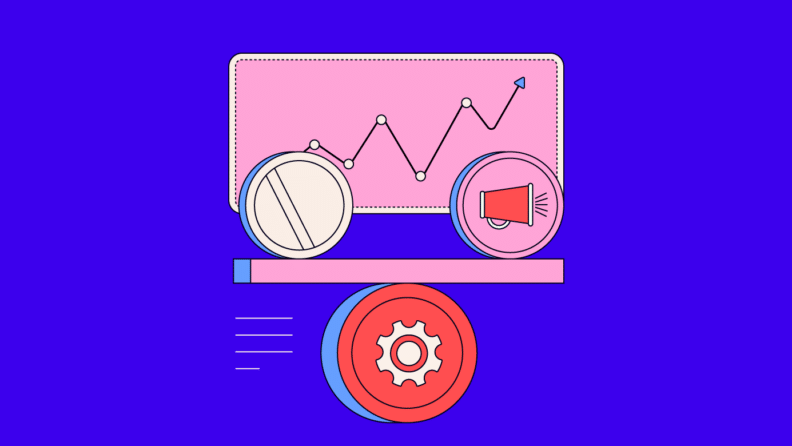If you're looking to make a case for a marketing automation program, then these marketing automation stats are a must-include in your business case deck for your CFO.
Stats that back marketing automation to improve ROI, I've got that. Productivity, same. Marketing automation and how it improves lead generation and social media management workflows, I've got stats to back it all up too. Soooo, let's get to it.
What is Marketing Automation?
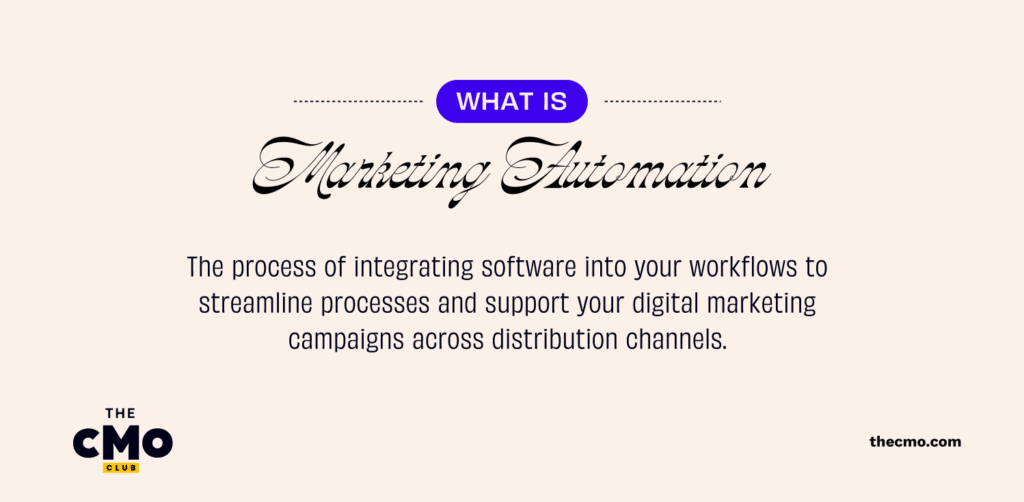
Marketing automation is the process of integrating software into your workflows to streamline processes and support your digital marketing campaigns across distribution channels.
Modern marketing demands both personalization and promptness; customers want to feel like they’re interacting with content that’s been designed specifically for them, and when they reach out for help or advice, they want an immediate response.
Automating repetitive tasks like social media posting and email marketing, or using a chatbot to provide an instant response to customer inquiries makes it easier to deliver a personalized customer experience and quality content without overloading the hard-working humans in your organization. The best marketing automation software can save you time by handling repetitive tasks, allowing you to focus on strategic planning and creative work.
Why Use Marketing Automation?

MarTech can boost your overall marketing efforts, from email marketing and lead management to cost reduction and revenue generation.
But wait, what is MarTech? Short for Marketing Technology, MarTech refers to a range of marketing software, tools, and technologies used to optimize, execute, and measure marketing campaigns and initiatives.
Marketing automation software is one component of a business’s MarTech stack.
For marketing automation to be successful, it should be used to achieve clearly defined goals with a focus on the customer and their needs. This is what separates companies that use marketing automation for small tasks from those that fully leverage its potential.
When used correctly, marketing automation delivers:
- Relevant and timely customer information
- Precise customer journey mapping
- Increased consumer trust trust
- Enhanced productivity and efficiency
Marketing Automation Statistics For ROI
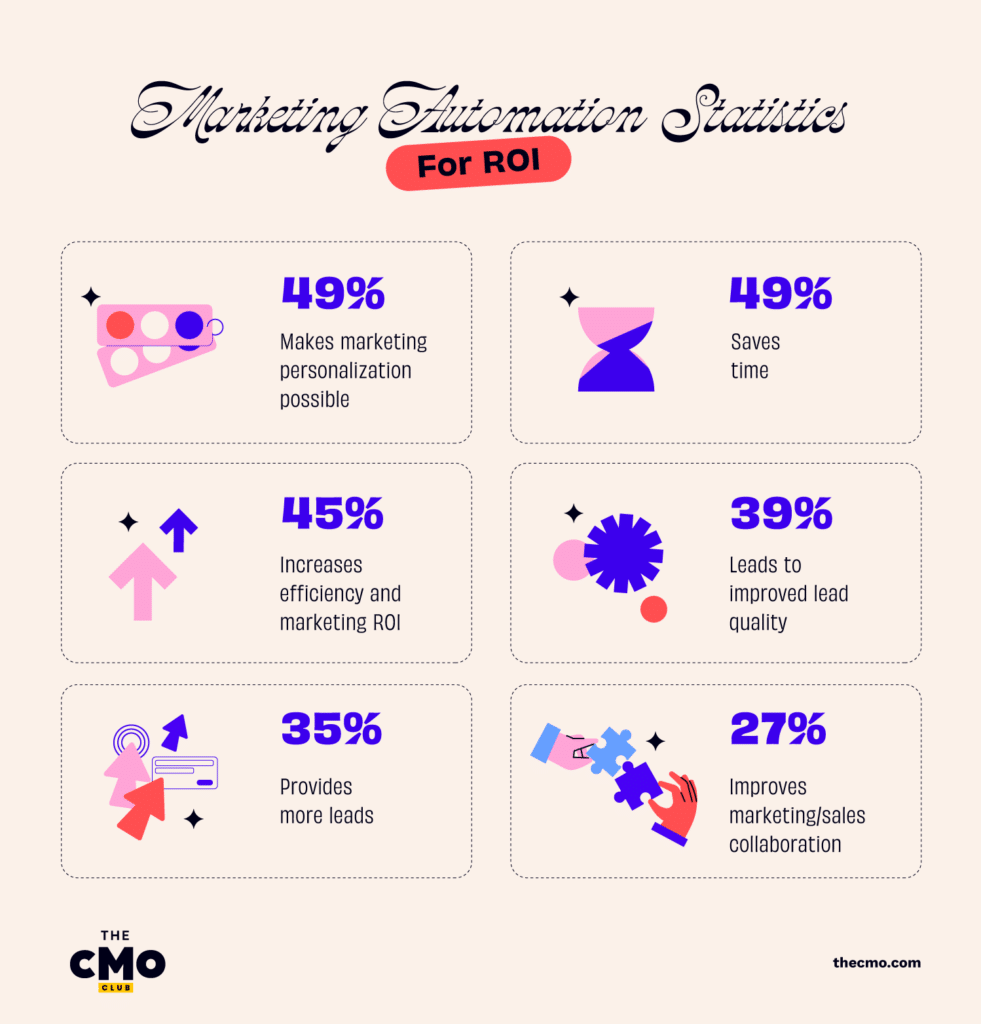
Marketing automation ROI measures the profitability and cost-effectiveness of marketing automation solutions and is one of the main factors businesses consider when investing in marketing automation software.
To calculate marketing automation ROI, divide the total net returns from the investment by the total costs. Below are some statistics for the average ROI of businesses using marketing automation.
- For every dollar spent on marketing automation, companies saw an average ROI of $5.44 in the first three years (Nucleus Research)
- On average, businesses recover the cost of their initial investment in marketing automation in under six months (Nucleus Research)
- The average company can expect automation to increase revenues by about 34% (Salesforce)
Marketing Automation Statistics for Productivity
Marketing automation solutions can reduce time spent on marketing activities and repetitive tasks, leading to time savings as well as a reduction in overhead.
By automating marketing activity and centralizing campaigns on a single marketing automation platform, more than one in ten businesses reported that they were able to reduce their overall marketing costs (Oracle).
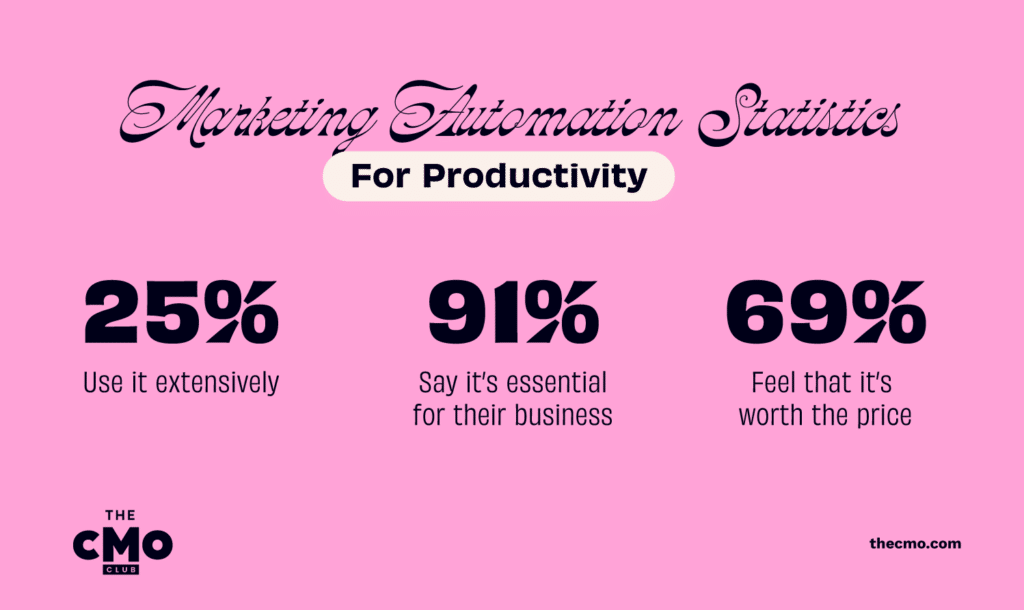
- 91% of marketers say marketing automation helps them achieve their objectives (Ascend2)
- Marketing automation helps develop leads and keeps them engaged for sales to close effectively. Marketing automation software can lead to a 14.5% increase in sales productivity (Oracle)
Marketing Automation Usage Statistics
Marketing automation is quickly becoming a key component in the marketing strategies of businesses worldwide. According to a survey by Pedalix, 34% of companies use marketing automation to a limited degree, while 25% have adopted it extensively. Meanwhile, 28% plan to implement it within the next two years and 13% are not using it at all.
- Email (63%), social media management, (50%) and paid ads (40%) are the most common use cases for marketing automation (Ascend2)
- During a February 2024 global survey among marketing decision-makers, almost 70 percent said they planned to increase their budget for marketing automation in the following year (Statista)
- Nearly two out of five marketers worldwide described their customer journeys as either mostly or fully automated (Statista)
- According to a 2022 global survey, marketers see five main advantages in that process: improving customer experience, enabling their staff to use time better, higher quality of data and decision-making, an improvement in lead generation and nurturing, and better use of budget (Statista)
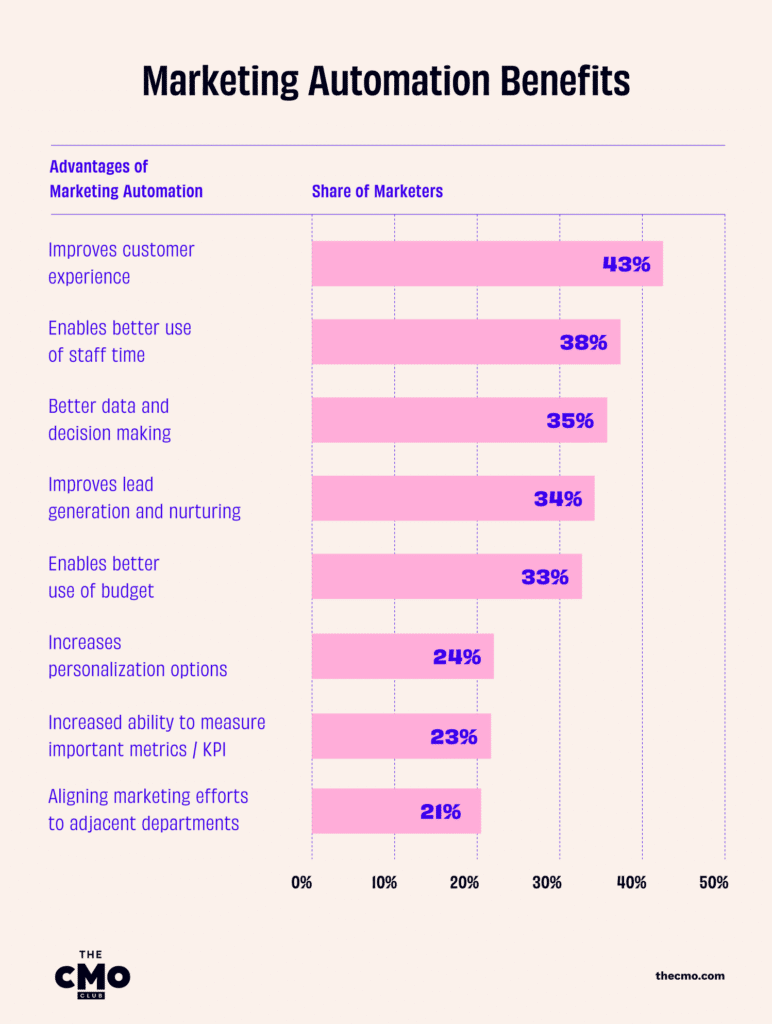
Email Marketing
Not only does email marketing automation help businesses save time and money by automating repetitive tasks, it also allows for personalized communication by leveraging marketing automation data quality to improve audience segmentation and send targeted messages, enhancing engagement and relevance.
Automation improves the efficiency of marketing campaigns through advanced tracking, data analysis, and optimized strategies.
- 31% of all email orders are a result of automated emails (Omnisend)
- Personalized email campaigns are responsible for 75% of email revenue (Softwarepath) Most marketing automation solutions offer advanced email marketing features.
Social Media Management
As I mentioned earlier, social media management is one of my favourite applications of marketing automation, making it easy to schedule posts ahead of time, track metrics, and understand which posts are the most successful.
25% of respondents to Aioma’s survey stated the distribution of content marketing via social media channels was essential for marketing automation software. With this feature, messages are shared automatically via the company’s own social media profiles such as LinkedIn, Facebook, and Instagram, based on data and tailored to the target group.
Lead Generation
Lead qualification involves evaluating criteria such as demographics, behavior, reactions, interests, and interactions with prospective clients.
The primary benefit of incorporating marketing automation in lead nurturing is the software’s ability to simplify this complex process and analyze behavior-based data from various marketing channels, actively supporting the marketing and sales goal of lead generation.
- Businesses using marketing automation have seen their number of leads rise by 80% (Softwarepath)
- Businesses using a marketing automation software when engaging prospects have seen a 451% increase in qualified leads (Softwarepath)
Lead qualification and lead scoring are essential functions of marketing automation software, as confirmed by 45 percent of businesses in an Aioma-sponsored study.
Marketing Automation Industry Statistics
In 2024, marketing automation continues to expand, with companies investing billions of dollars annually to support and improve this faction of their business.
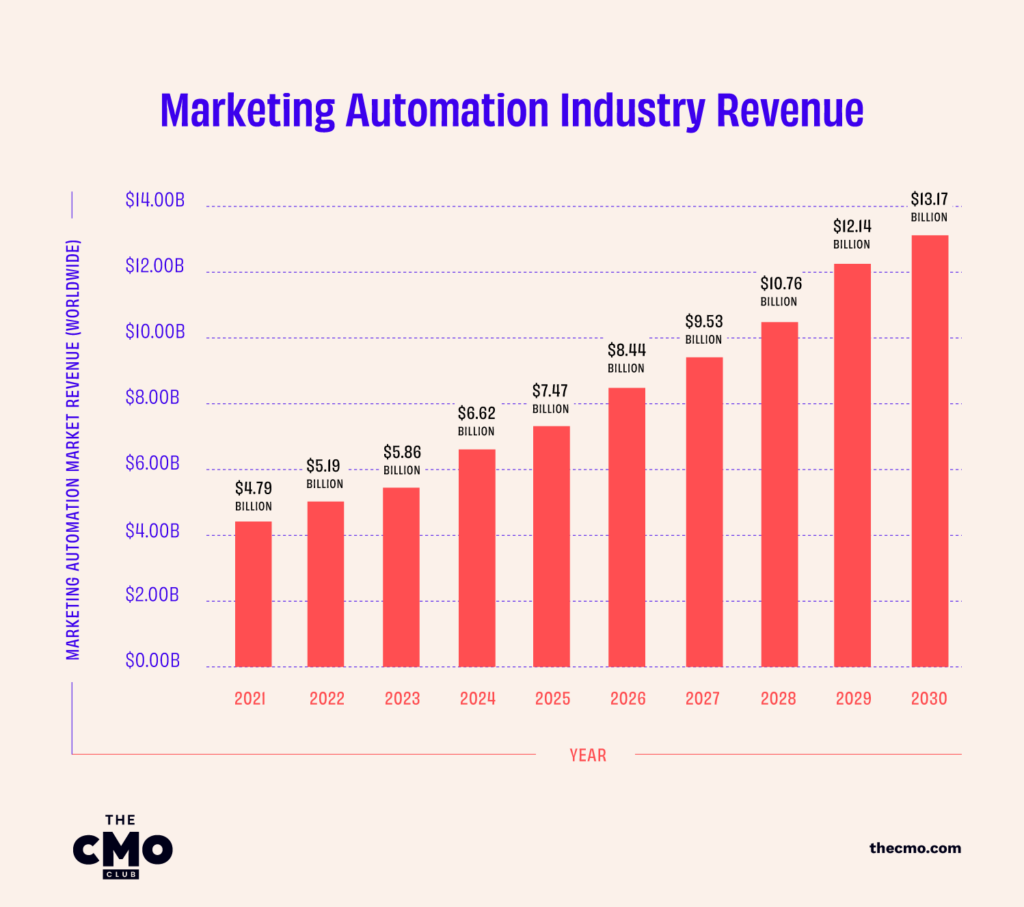
- Between 2021 and 2023, the global marketing automation industry revenue grew by an estimated 22 percent to 5.86 billion U.S. dollars (Statista)
- By 2030, the value of the global marketing automation market is expected to reach $13.71 billion (Polaris)
- Hubspot continues to dominate the marketing automation software market with a market share of 38.27%. Other major players in the marketing automation tools space include Adobe Experience Cloud (7.97%), Welcome (7.68%), Oracle Marketing Cloud (7.37%) and Active Campaign (6.99%) (Datanyze)
Marketing Automation Challenges
The biggest challenge for marketing teams in choosing a vendor is understanding the differences in features and functionality. This gap often leads to mismatches between needs and software capabilities. As a result, 70% of marketers are unhappy with their automation software, and 85% of B2B marketers feel they aren't using it to its full potential (TechCrunch).
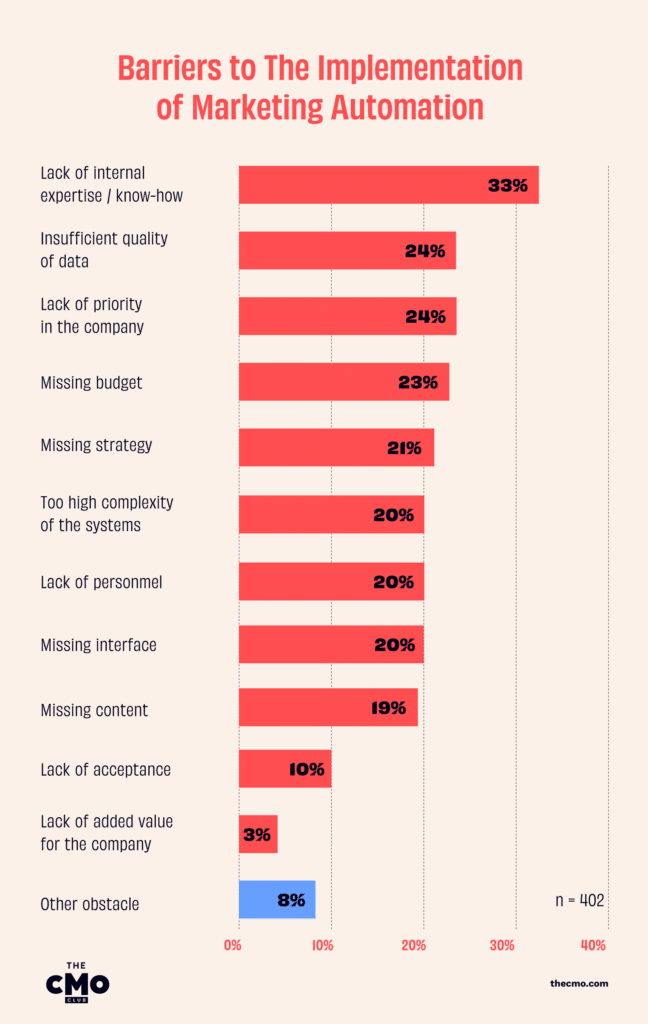
Another challenge for businesses is a lack of marketing automation budget. While marketing automation doesn't have to be expensive, many small and medium-sized enterprises (SMEs) hesitate to invest in it. Only 44% of companies with low budgets and 50% with medium budgets can afford marketing automation tools, compared to 81% of large-budget companies (Aioma).
What are some of the other challenges in preventing marketing professionals from using their automation tools to their fullest potential?
According to MarTech Series:
- 60% of companies struggled with ease of use, finding implementation difficult
- Only 17% of marketers use A/B testing on landing pages to improve conversion
- 16% find creating quality automation a challenge
- 10% of companies across all industries found it difficult to create content
- Only 8% of companies use marketing automation to engage with current customers
The State of Marketing Automation
The future looks bright for marketing automation, which is quickly becoming an indispensable resource for companies that want to remain competitive in the digital landscape.
Marketing automation helps B2B companies connect with consumers at the right time, through the right channel, with the right message, all while saving time on repetitive tasks, boosting efficiency, and enhancing customer engagement.
By generating higher-quality leads and improving conversion rates, marketing automation supports customer care and loyalty. It also fosters better collaboration between marketing and sales teams, which is increasingly important for the optimization of marketing results.
For more expert insights and some of the best tips on marketing automation, I highly recommend you subscribe to The CMO newsletter. You’ll get all the very best content straight to your inbox.

